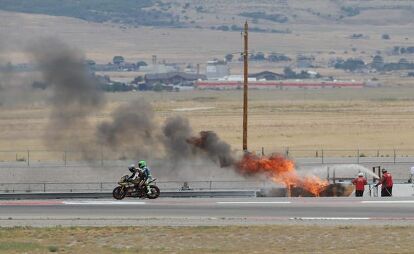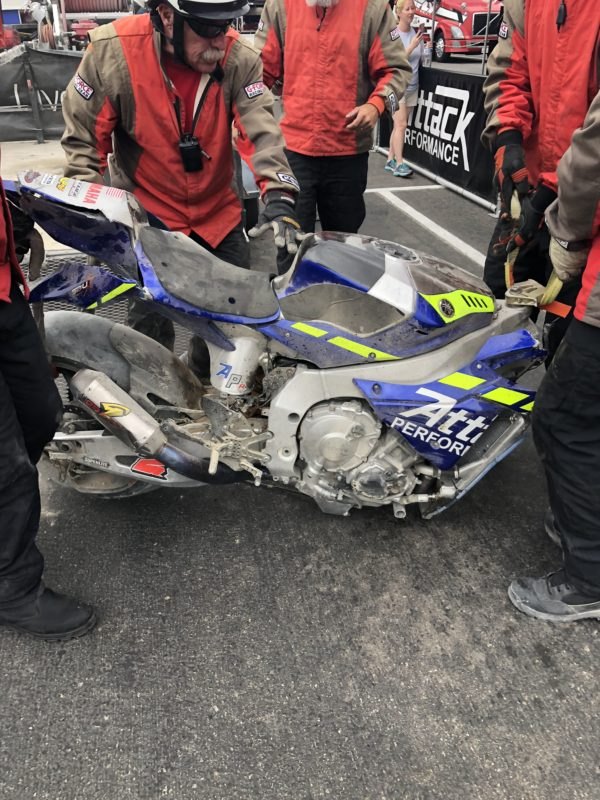One Superbike to Rule Them All… Until It Crashes
This past weekend’s Round Six MotoAmerica race at Utah Motorsports Park witnessed a couple of spectacular crashes, with both riders fortunately walking away pretty much unscathed. Their bikes, though? Not so much…
MotoAmerica:
Among the crashes during round six of the 2018 MotoAmerica Superbike Championship last weekend at Utah Motorsports Park, the two most notable ones were by defending champ and Yoshimura Suzuki Factory Racing rider Toni Elias on Friday during Superbike Qualifying Practice 1 and by Attack Performance/Herrin Compound/Yamaha rider Josh Herrin during Sunday Morning Superbike warmup.
Both incidents were spectacular to behold. Elias’ get-off started out as a simple lowside up and ended up in a conflagration, or as Elias described it, a “an America-Japanese barbecue.” Herrin’s moment began and ended in drama, with him highsiding to the sky as his bike cartwheeled off the track and separated its handlebars, forks, front wheel, and front brakes from the rest of the machine.
While Elias was none the worse for wear, his Suzuki GSX-R1000 Superbike was charred almost beyond recognition. Herrin bruised his tailbone and right hand, but was mostly okay, while his Yamaha YZF-R1 Superbike was a bona fide basket case.
When Elias was able to start the race on Saturday and also on Sunday, but Herrin was unable to start on Sunday despite appearing relatively fit physically, many fans wondered how MotoAmerica’s one-bike rule affected the situation. With both Elias’ and Herrin’s bikes destroyed, wouldn’t the one-bike rule have prevented both riders from racing?
The short answer is “No,” but let’s look at the rule, which appears verbatim below:
1.18.4 Motorcycle use
- During the event, a rider may only use a motorcycle that has been presented for technical control, according to the procedures described in articles 2.4.10, 2.5.10, 2.6.10, 2.8.10 and 2.9.10 of the Technical Regulations.
- Superbike riders may use the primary motorcycle presented for technical control at any time during the event. Riders are allowed one complete spare motorcycle. Only one motorcycle may be presented for preliminary technical checks and it will be the only motorcycle allowed on the track and in the pit box during the practices, qualifying, Superpole and races. If the technical director declares the primary motorcycle unrepairable, the spare motorcycle may then be presented for scrutineering before the next session. For a full explanation of procedures see article 2.4.10.
- All other classes may only use the motorcycle presented for technical control.
2.4.10 Main frame and spare motorcycle
- During the entire duration of the event each rider may only use one (1) complete motorcycle, as presented for technical control, with the frame clearly identified with a seal. In case the frame needs to be replaced, the rider or the team must request the use of a spare frame to the technical director.
- One (1) spare complete motorcycle is allowed per rider.
- A team may opt to have one (1) spare machine shared by two or more riders.
The 2018 MotoAmerica AMA Road Racing Series FIM North America Championship Regulations provide a more detailed Explanation of Procedures, but for the sake of brevity, we will not venture down that path here. Suffice to say that the one-bike rule is clear and does not prevent a rider who crashed his motorcycle into oblivion from racing a different motorcycle during the same race weekend.
According to Don Sakakura, Senior Vice President at Yoshimura R&D of America, Inc., and the man in charge of Yoshimura Suzuki Factory Racing, their team carries a spare Superbike on their team transporter for just such an occasion. They pulled the bike out of the truck, prepped it with Elias’ current suspension and electronics settings, presented it to technical control, and Elias raced it on both Saturday and Sunday.
Herrin’s situation was a little different. His team didn’t have a spare motorcycle in their transporter although, according to the rules, they could have. That would have been Plan A for their team. Plan B would have been to rebuild Herrin’s crashed motorcycle. Unfortunately, Plan B was also a no-go, mostly because of the broken triple clamps, bent forks, bent swingarm, and broken frame on Herrin’s R1. If team owner and crew chief Richard Stanboli had replacement components available on the Attack Performance/Herrin Compound team transporter, then they may have been able to put together a second motorcycle provided that they could have built a bike from the frame up in the few hours between when Herrin crashed in morning warmup and when the race went green at 3:30 p.m..
But, what definitely kept Herrin from lining up for Sunday’s Superbike was a wiring harness. Unlike some of the Superbike teams that use OEM or race-kit wiring harnesses on their motorcycles, Stanboli builds his own. It’s a complicated network of wires connectors, and sensors that is an absolute work of art as well as the vital and central nervous system for Herrin’s machine. It also takes many, many man-hours for Stanboli to create a complete wiring harness for Herrin’s R1 Superbike. At Utah, Stanboli understandably had one and only one wiring harness available, and it was destroyed when Herrin’s bike violently tumbled, jettisoned parts, and basically tore itself apart. Game over for Herrin.
So, unlike J.R.R. Tolkien’s “Lord of the Rings” trilogy about “one ring to rule them all,” the MotoAmerica Superbike teams do have one bike to race, but that doesn’t mean it’s the only bike they can race. The rules have provisions to help teams stay in the game, but in Josh Herrin’s case, staying in the game on Sunday was unfortunately not possible.
More by Press Release

































Comments
Join the conversation